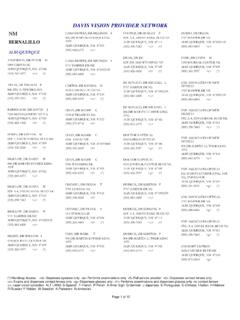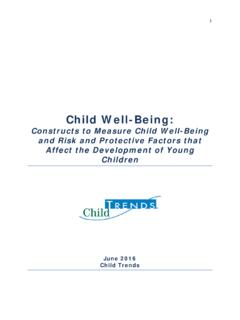Transcription of Revised Conflict Tactics Scales (CTSZ) - Martin Sewell
1 The Revised Conflict Tactics Scales ( ctsz ) CTSI 5 Develoyrnent and Preliminary Psycllor~retric Data copyright Notice. Western Psychological Services (WPS) is now the publisher ofthe CTS2 and the CTSPC For Pe~mission to reproduce copies of these instruments, or to purchase printed copies, click on INFORMATION ON PURCHASING COPIES OF THE CTS, MURRAY A. STRAUS SHERRY L. HAMBY University of New Harr~pshire SUE BONEY-McCOY Eastern Corwecticut State University DAVID B . SUGARMAN Rhode Islard College Tlis article describes a Revised Conflict Tactics Scales (the nS2) to measure psychological ;uld physical attacks on a partner in a marital, cohabiting, or dating relationship; and also use of The ffS2 has (a) additional items to enhance content validity and reliabiliv.
2 The Conflict Tactics Scales , or CTS (Straus, 1979,1990a), measures both the extent to which partners in a dating, cohabiting, or marital relationship engage in psychological and physical attacks on each other and also their use of reasoning or negotiation to deal with conflicts . The most frequent application of the CTS has been to obtain data on physical assaults on a partner. (b) Revised wording lo ir~crease clarity a~d specificity; (c) better differentiation behveen Illinor and severe levels of each scale ; (d) new Scales to ~neasure sexual coercion a11d physical irljury; and (e) a new forr~lat to sir~lplify adr~urustration and reduce response sets.
3 Reliability rages fro]" .79 to .95. There is preli~luniuy evidence of construct validity. Authors' Note: Revision of a paper presented at the Theory and Methodology Workshop during the annual nleeting of the National Council on Family Relations in Portland. Oregon, November 15, 1995. It is apleasure to express appreciation to Susan Ross for he initial work on rhe injury scule; to the members of the Funlily Research Laboratory Seminar; and to the discussants of the conference presentation, hzce C. Egley, Patrick C. McKenry, and Constance L. Sllelran.
4 This article is a publication of the Measuren~ettt Research Progran~ of the Fwnily Researclr Laboratory, University of New Hwrlpsltire, Durluur~, New Hampshire 03824. A list ofpublications will be sent on request. The research lurc beenfunded by National Itjstitute ufMental Health Crw~t T32MH15161 wtd the University of New Hatryshire. JOURNALOF FAMILY ISSUES. Vol. 17 No. 3. May 1996 283-316 8 1996 Snge Publicatio~~s. 11~. 284 JOURNAL OF FAMILY ISSUES 1 May 1996 Straus et al. I Revised Conflict Tactics scale 285 The CTS has been used in many studies since 1972 involving more than 70,000 participanls from diverse cultural backgrounds, including African Americans (Cazenave & Straus, 1979; DuRant, Cadenhead, Pen- dergrast, Slavens, & Linder, 1994; Hampton, Gelles, & Harrop, 1989) and Hispanic Americans (Kaufman Kantor, Jasinski, & Aldarondo, 1994).
5 The CTS has also been used successfully in at least 20 countries, including Hong Kong (Tang, 1994), India and Japan (Kumagai & Straus, 1983), Israel (Eisikovits, Guttmann, Sela-Amit, & Edleson, 1993), Spain (Hin- shaw & Forbes, 1993), and Sweden (Gelles and Edfeldt, 1986). The CTS is increasingly being used as a diagnostic aid in family therapy (Aldarondo & Straus, 1994; O'Leary & Murphy, 1992). Approximately 400 papers have been based on data obtained by use of the CTS (see bibliography in Straus, 1995), including studies that have established its validity, reliabil- ity, and factor structure (reviewed in Straus, 1990a).
6 In 1994, articles reporting findings based on use of the CTS were published at a rate of about 10 per month. An instrument that is this widely used needs to be examined carefully, and there has been a number of suggested revisions. This article describes the steps taken to revise and enlarge the CTS and reports preliminary psychometric data on the Revised version. COMPARISON OF ORIGINAL AND Revised CTS From this point on, for economy and accuracy, CTS 1 will refer to the original CTS, and CTS2 to the Revised CTS. Statements that apply to both versions will use CTS.
7 THEORETICAL BASIS AND MODE OF OPERATIONALIZATION Despite the important differences between CTS 1 and CTS2, the theol retical basis and mode of operationalization are fundamentally the same. The theoretical basis of the CTS is Conflict theory (Adam, 1965; Coser, 1956; Dahrendorf, 1959; Scanzoni, 1972; Sirnmel, 1955; Straus, 1979). This theory assumes that Conflict is an inevitable part of all human association, whereas violence as a tactic to deal with Conflict is not. Measures concrete acts and events. The CTS measures the extent to which specific Tactics , including acts of physical violence, have been used.
8 The CTS is not intended to measure attitudes about Conflict or violence nor the causes or consequences of using different Tactics . The focus on specific acts or events is a strength of the CTS. Some scholars, however, view the focus on specific acts as a limitation (Dobash & Dobash, 1979; Kurz, 1993). They fault the CTS for measuring acts out of context. The criticism that the CTS does not take into account the context and meaning of the acts is analogous to criticizing a reading ability test for not identifying the reasons a child reads poorly (such as limited exposure to books at home or test anxiety) and for not measuring the harmful effects of reading difficulty (such as low self-esteem or dropping out of school).
9 These types of issues are critical, but they must be investigated by including measures of those explanatory, context, or consequence vari- ables along with the reading test. Similarly, the CTS is intended to be used in conjunction with measures of whatever cause, context, and consequence variables are relevant for the study or the clinical situation. This includes variables that are simple to measure but basic for understanding the connotations and meaning of the CTS scores, such as gender, age, height, and weight; and equally funda- mental but more difficult to measure variables, such as the balance of power, feelings of fear and intimidation, and injury.
10 Indeed, injury is such an important consequence that the Revised CTS includes a scale to measure physical injury. It is important to note, however, that this is a separate scale , not part of the physical assault scale (see Straus, 1990a, 1990b, for why it is extremely important to separately measure physical assaults and injuries). Moreover, in their own research, some key critics of the CTS have contradicted their own criticism by following the CTS approach of asking about a list of assaultive acts to obtain the measure of physical violence and using a separate measure of injury (see for example, Dobash, Dobash, Cavanagh, & Lewis, 1994; Statistics Canada, 1993).





